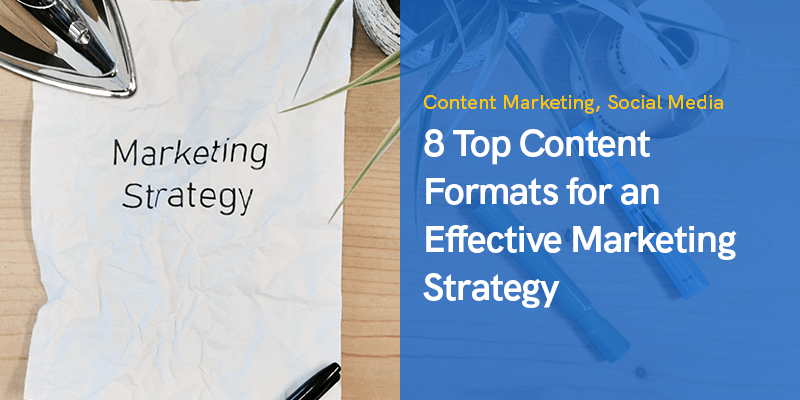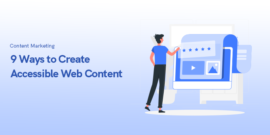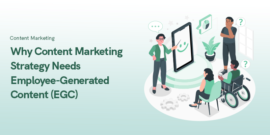
8 Top Content Formats for an Effective Marketing Strategy
Table of Contents
ToggleWhat's the most effective form of marketing available in this digital age? It isn't content marketing for sure.
Email marketing remains a dominant form of promotional campaigning in social media and artificial intelligence in today's world.
Surprisingly, emails have an ROI of 4400%, which is massively impressive! Though content marketing proudly comes second only to this traditional technique.
Small companies that blog acquire 126% more growth than companies that don't publish any content.
Now, is content marketing only limited to blogs and articles? That's a common misconception people often have.
They think that only old-fashioned text-based paragraphs constitute content in the 21st century.
Innovative Content Formats for Small Businesses
Doubtlessly, written content won't cease bringing you a gigantic portion of the digital audience.
But people are slowly becoming more responsive to content accompanied by voice, images, and videos.
Hence, having strategy docs can help create content that aligns with your business and get the interest of your potential consumers.
So, relying exclusively on articles may prevent your company from leveraging future opportunities in its favor.
Experiment with various media to convey your message to your audience.
Since not everyone's interested in reading textual publications.
Here are some trendy content formats you can try:
Gated Content
This format involves offering certain portions of an asset for public viewing and locking the rest of it.
For instance, allow anyone to study the first few ebook pages but restrict full access to the product.
People interested in reading the full ebook can unlock it by revealing their contact information.
Mostly, they'll subscribe by entering their email, and then the ebook sends to that address.
This strategy brings high-quality visitors to your website and enhances the brand's SEO efforts.
Some 80% of B2B companies lock their assets since it improves their list-building endeavors.
Now, you can “gate” different sorts of content formats explained below.
Podcasts
The new generation isn't a stranger to the concept of podcasts.
They've become a well-liked content format on video-sharing platforms such as YouTube.
People sitting around a singular table talking casually about a specific subject have a unique charisma associated with it.
Around one-fifth of American adults watch or listen to a podcast every week.
There are many effective ways to grow your podcast audience by reaching the right people.
You can convert a file into an audio format or read your existing article aloud.
Moreover, publishing often and uploading transcripts can also facilitate more people to find your podcast.
A multi-episode podcast is often more effective.
Webinars
A “webinar” is just a web-based seminar.
It is an online conference, and attendants participate in the meeting digitally.
The coronavirus pandemic has made webinars popular sources of communication in the content marketing industry.
Research shows that around 20-40% of people who attend these seminars become qualified leads.
And some 2-5% of them do purchase something from your company.
You might be using Zoom to attend your business meetings.
This platform also allows you to have a 40-minute long session with up to 100 attendants.
In most webinars, the host shows a presentation followed by a Q&A session to increase the audience's engagement.
Infographics
Do you know that over two-thirds of B2B content marketers produced infographics back in 2020? And more than 80% of companies that used infographics have found them effective.
Remember that visuals are better at motivating people to purchase from you since your audience would be more excited about a graphically-elaborated piece of information than written content.
Visuals entice people while making information reliable, shareable, and actionable.
You can also use online tools such as Canva or Piktochart to create visually-appealing infographics.
Give it an attention-grabbing headline and then divide the below-mentioned information into several attractive subheadings.
Long-Form Articles
How long do you think an average blog is? Some bloggers write 500-worded content, but the average word length barely exceeds 1200 words.
But now, people are beginning to focus on the production of even lengthier articles with 1,000-20,000 words! Why even write such a wordy post? Well, long-form content is more visible and gives a higher conversion rate.
And do you think users won't bother sharing lengthy research-paper-looking articles? Surprisingly, an article's shareability increases with the word count, a recent study has revealed.
Moreover, lengthy posts appear more professional than short-form articles that seem too abrupt and to-the-point.
Case Studies
Honestly, case studies are just feel-good stories that describe how your brand helped customer/s overcome some problems.
You explain how your products/services matter to your target audience.
Since over 90% of consumers refer to product reviews before making a purchase decision.
These people need to know that your company is trustworthy.
That's what case studies attempt to do! They establish trust among your niche and produce content specific to their liking.
Remember that there's a crucial difference between a case study and a white paper.
Former describes a real-life event while the latter proposes solutions to issues encountered by your target audience.
GIFs
The graphic interchange format was invented in the '80s but has recently become popular in the content marketing industry.
These animated pictures can eloquently describe a bunch of emotions with their storytelling prowess.
These images can also be embedded easily like JPEGs and are massively shareable.
Their unique motion effect makes them mobile-friendly and provides businesses a higher open rate.
As content marketing is becoming more visual, GIFs will continue growing into popularity since people tend to forget mere text-based content after a few days.
Ebooks
In the end, let's talk about a dominant content format in the market right now.
Studies show that ebooks, case studies, and social media updates are the most famous content types in B2B content marketing.
And ebooks are used by 50% of marketers! These digital manuscripts have grown in popularity since much information can store in a single hand-held gadget.
Companies can produce ebooks conveniently, sometimes by just repurposing their published articles together.
Users can download them, share them online, and carry them wherever they wish.
They make the most effective lead magnets to build your email subscribers' list in 2021.
Conclusion
Do merely written articles count as a content marketing format? Probably.
But success-oriented firms don't depend solely on blogging or publishing text-based content.
They find innovation in this campaign and bring special categories of content to awaken people's purchasing desire.
Do you know that content remains one of the most crucial SEO ranking factors today? Choosing the correct content format helps your target audience find you more easily.
They may also stick around for a while and even buy something from you.
Formats such as infographics and podcasts are less costly when compared to professionally-authored articles.
So, identify something that resonates with your audience's interests and try repurposing a single content into different formats.
Recommended Posts

9 Ways to Create Accessible Web Content
January 16, 2024



The only information you have is the name of the individual and the name of the organization. We’ve seen it all before, so we know exactly what you’re looking for. We recommend using our Getprospect B2B prospecting strategies for a quick search of the sorts of prospects you’re looking for. Professional services like Getprospect make it easy for you to choose the right partner!